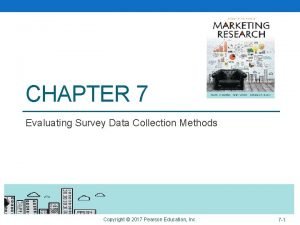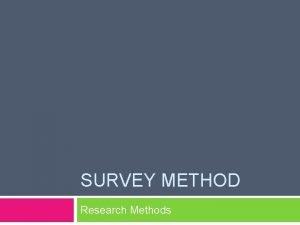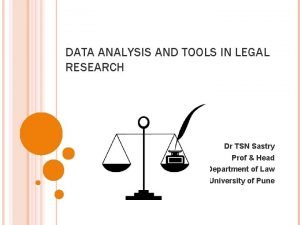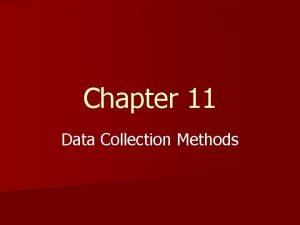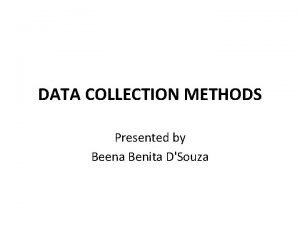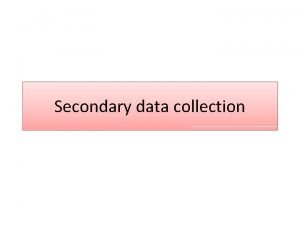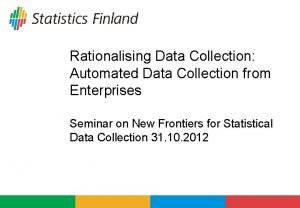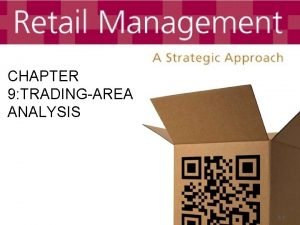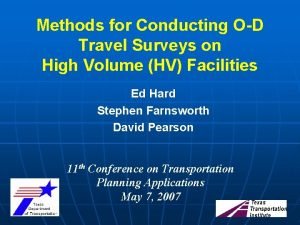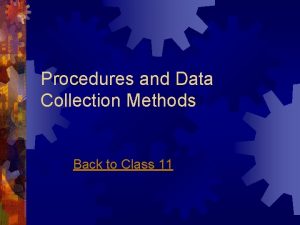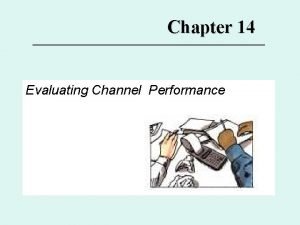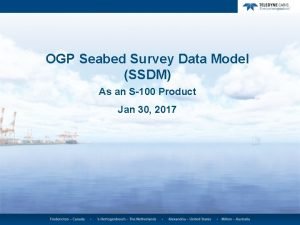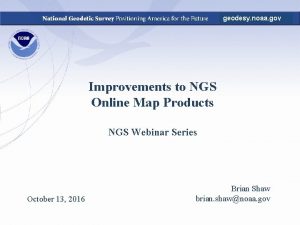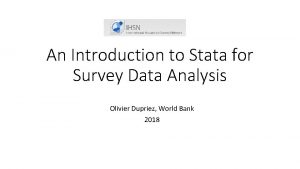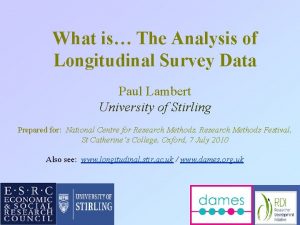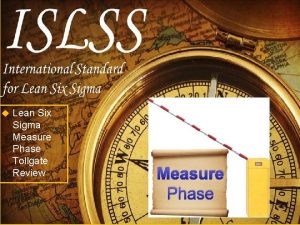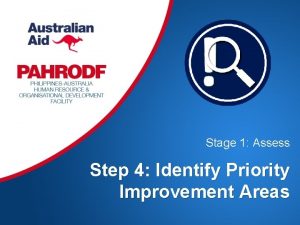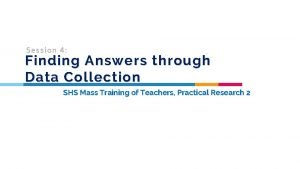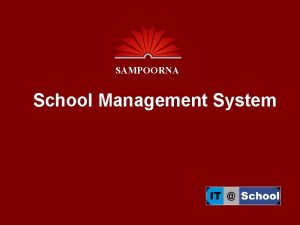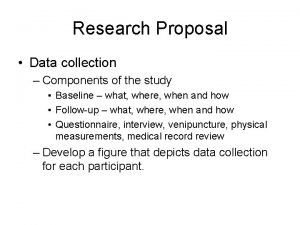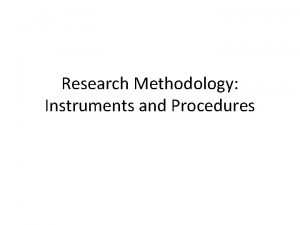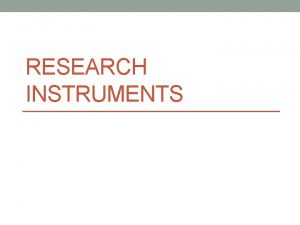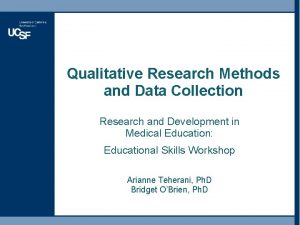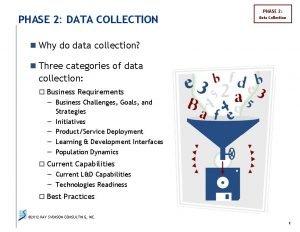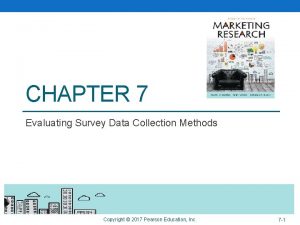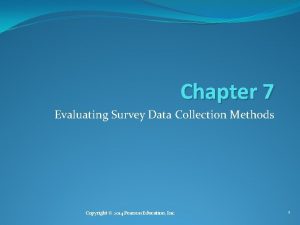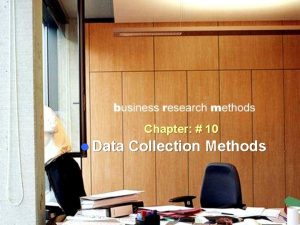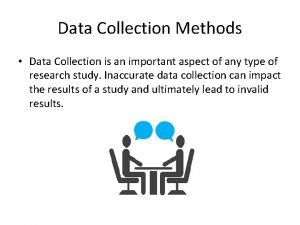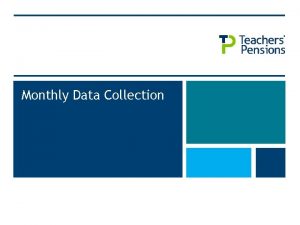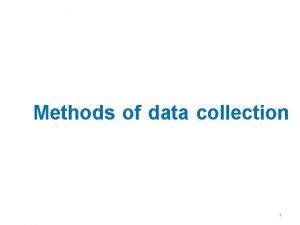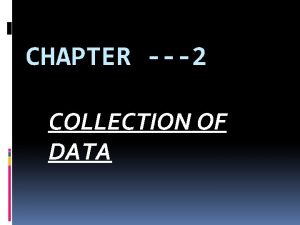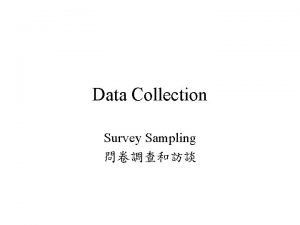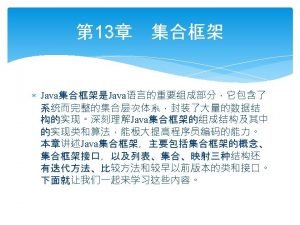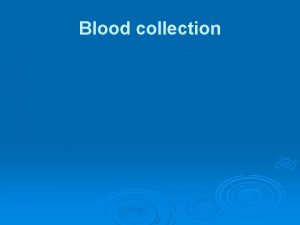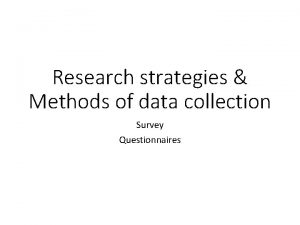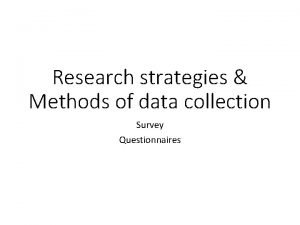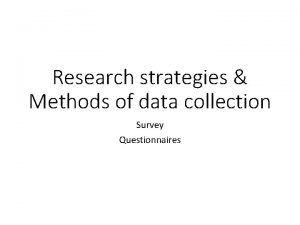Chapter 7 Evaluating Survey Data Collection Methods Copyright




































- Slides: 36

Chapter 7 Evaluating Survey Data Collection Methods Copyright © 2014 Pearson Education, Inc. 1

Learning Objectives �To learn the four basic alternative modes for gathering survey data � To understand the advantages and disadvantages of each of the various data collection modes �To comprehend the factors researchers consider when choosing a particular survey method �To become knowledgeable about the details of different types of survey data collection methods, such as personal interviews, telephone interviews, and computeradministered interviews, including online surveys Copyright © 2014 Pearson Education, Inc. 7 -2

Copyright © 2014 Pearson Education, Inc. 7 -3

Contemporary Survey Copyright © 2014 Pearson Education, Inc. 7 -4

Surveys �A survey involves interviews with a large number of respondents using a predesigned questionnaire. • Four basic survey methods: 1 -Person-administered surveys 2 -Computer-assisted surveys 3 -Self-administered surveys 4 -Mixed-mode (hybrid) surveys Copyright © 2014 Pearson Education, Inc. 7 -5

Advantages of Surveys 1 -Standardization 2 -Ease of administration 3 -Ability to tap the “unseen” 4 -Suitability to tabulation and statistical analysis 5 -Sensitivity to subgroup differences Copyright © 2014 Pearson Education, Inc. 7 -6

Copyright © 2014 Pearson Education, Inc. 7 -7

Data Collection Modes 1 -Person administered Surveys: an interviewer reads questions, either face-to-face or over the telephone, to the respondent and records his or her answers. • Advantages: – Feedback – Rapport – Quality control – Adaptability Copyright © 2014 Pearson Education, Inc. 7 -8

• Disadvantages: a)Humans make errors b)Slow speed c)High cost d)Interview evaluation: apprehensive they are answering the question “correctly. ” Feel they are being “evaluated. ” Especially a problem with sensitive topics such as hygiene, finances, political opinions, etc. Copyright © 2014 Pearson Education, Inc. 7 -9

2 - Computer-Assisted Surveys; the interviewer basically verbalizes the question while relying to some degree on computer technology to facilitate the interview work. • Advantages: - Speed - Relatively error-free interviews - Use of pictures, videos, and graphic - Quick capture of data Copyright © 2014 Pearson Education, Inc. 7 -10

• Disadvantages: -Technical skills nay be required -Setup costs can be high Copyright © 2014 Pearson Education, Inc. 7 -11

3 -Self-administered: the respondent completes the survey on his or her own. -Traditional “paper and pencil” survey • Advantages: – Reduced cost – Respondents control pace at which they answer – No interview-evaluation apprehension • Disadvantages: – Respondent controls the survey—does not send in on time or does not send in. – Lack of monitoring—no one to explain or encourage respondents. – High questionnaire requirements—it must be perfect. Copyright © 2014 Pearson Education, Inc. 7 -12

4 -Computer administered surveys: a computer plays an integral role in posing the questions and recording respondents answers. • Advantages: – Breadth of user-friendly features – Relatively inexpensive – Reduction of interview evaluation concern in respondents • Disadvantages: – Requires computer-literate and Internetconnected respondents Copyright © 2014 Pearson Education, Inc. 7 -13

Copyright © 2014 Pearson Education, Inc. 7 -14

5 -Mixed-mode surveys use multiple data collection methods. • It has become increasingly popular to use mixed-mode surveys in recent years. • Advantages: – Multiple advantages to achieve data collection goal – Example: May use online surveys to quickly reach portion of population with Internet access and may use telephone calling to reach those without Internet access. Copyright © 2014 Pearson Education, Inc. 7 -15

• Disadvantages: – Mode affects response? – Additional complexity Copyright © 2014 Pearson Education, Inc. 7 -16

PERSONADMINISTERED/ COMPUTERASSISTED SURVEY COMPUTERADMINISTERED SURVEYS SELFADMINISTERED SURVEY Copyright © 2014 Pearson Education, Inc. 7 -17

Descriptions of Data Collection Methods First; Person-Administered Interviews; 1 - in-home survey is conducted by an interviewer in the home of the respondent. • In-home interviews are used when the survey requires respondents to see, read, touch, use, or interact with product prototype and when the researcher believes the security and comfort of respondents homes are important in affecting the quality of the data collected. Copyright © 2014 Pearson Education, Inc. 7 -18

�Key advantages: -Conducted in the privacy of the home, which facilitates interviewer–respondent rapport Copyright © 2014 Pearson Education, Inc. 7 -19

2 -Mall-Intercept Surveys • The mall-intercept survey is one in which the respondent is encountered and questioned while he or she is visiting a shopping mall. • Key advantages: – Mall-intercept interviews are conducted in large shopping malls, and they are less expensive per interview than are in-home interviews • Key disadvantages: – Only mall patrons are interviewed. – Respondents may feel uncomfortable answering the questions in the mall. Copyright © 2014 Pearson Education, Inc. 7 -20

3 -In-Office Surveys • In-office surveys take place in person while the respondent is in his or her office or perhaps in a company lounge area. • Key advantage: – Useful for interviewing busy executives • Key disadvantages: – Relatively high cost per interview – Gaining access is sometimes difficult Copyright © 2014 Pearson Education, Inc. 97 -21

4 - Telephone Surveys; • Central Location Telephone Surveying Involves a field data collection company installing several telephone lines at one location from which interviewers make calls. • Key advantages: – Fast turnaround – Good quality control – Reasonable cost Copyright © 2014 Pearson Education, Inc. 7 -22

• Key disadvantage; 1 -The respondent cannot be shown anything or physically interact with the research object. 2 -The telephone interview does not permit the interviewer to make the various judgments and evaluations that can be made by the inperson interviewer. 3 -Marketing researchers are more limited in the quantity and type of information they can obtain. 4 - The growing threat to its existence as a result of increased noncooperation by the public. Copyright © 2014 Pearson Education, Inc. 7 -23

CATI; • The most advanced telephone interview companies have computerized the central location telephone interviewing process with systems called computer-assisted telephone interviews (CATI). • With CATI, the interviewer reads the questions on a computer screen and enters respondents answers directly in to the computer program. Copyright © 2014 Pearson Education, Inc. 7 -24

• Key advantages: -With CATI, the interviewer is the voice of the computers. -Most CATI systems are programmed to reject wrong answers. Copyright © 2014 Pearson Education, Inc. 7 -25

Second : Computer- Administerd interviews 1 -Fully Automated Survey • Some companies have developed fully automated surveys in which the survey is administered by a computer but not online. • In the research industry, this approach is known as completely automated telephone survey (CATS). Copyright © 2014 Pearson Education, Inc. 7 -26

• Key advantages: – Respondent responds at his or her own pace – Computer data file results 2 -Online Interviews; • The Internet-based questionnaire in which the respondent answers questions online has become the industry standard for surveys. Copyright © 2014 Pearson Education, Inc. 7 -27

• Key advantages: – Ease of creating and posting – Fast turnaround – Computer data file – Results • Key disadvantage: – Marketing researchers were quick to realize that online surveys presented design challenges and opportunities related to fostering cooperation in potential respondents. Copyright © 2014 Pearson Education, Inc. 7 -28

Thirdly : Self-Administered Survey 1 - group self-administered survey entails administering a questionnaire to respondents in groups rather than individually for convenience and to gain economies of scale. • Key advantages: – Cost of interviewer eliminated – Economical for assembled groups of respondents • Key disadvantage: – Must find groups and secure permission to conduct the survey Copyright © 2014 Pearson Education, Inc. 7 -29

2 - drop-off survey is sometimes called “drop and collect, ” in which the survey representative approaches a prospective respondent, introduces the general purpose of the survey to the prospect, and leaves it with the respondent to fill out on his or her own. • Key advantages: – Cost of interviewer eliminated – Appropriate for local market surveys • Key disadvantage: – Generally not appropriate for large-scale national survey Copyright © 2014 Pearson Education, Inc. 7 -30

3 - mail survey is one in which the questions are mailed to prospective respondents who are asked to fill them out and return them to the researcher by mail. • Key disadvantage: – Nonresponse, which refers to questionnaires that are not returned – Self-selection bias, which means that those who do respond are probably different from those who do not fill out the questionnaire and return it Copyright © 2014 Pearson Education, Inc. 7 -31

Copyright © 2014 Pearson Education, Inc. 7 -32

Choice of Survey Method • In selecting a data collection mode, the researcher balances quality cost , time, and other consideration. • How much time is there for data collection? -Sometimes data must be collected quickly. -There are many reasons for tight. • How much money is there for data collection? -We should know the budget of the compny. Copyright © 2014 Pearson Education, Inc. 7 -33

• What type of respondents interaction required? - If respondents need to see, handle, or experience something, the data collection mode must accommodate these requirements. • What is the incidence rate? -The incidence rate , the percentage of the population that possesses some characteristic necessary to be included in the survey, affects the decision about data collection mode. Copyright © 2014 Pearson Education, Inc. 7 -34

• Are there cultural and/or infrastructure considerations? -Cultural norms and/or limitations of communications systems may limit the data collection mode choice. Copyright © 2014 Pearson Education, Inc. 7 -35

Copyright © 2014 Pearson Education, Inc. 7 -36
 What is self administered survey
What is self administered survey What is survey method
What is survey method Types of data collection methods
Types of data collection methods Legal research tools and techniques
Legal research tools and techniques Observational data collection methods
Observational data collection methods Observation methods of data collection
Observation methods of data collection What is primary data
What is primary data Automated data collection methods
Automated data collection methods Factors to consider in evaluating retail trading area
Factors to consider in evaluating retail trading area Acls abcde secondary survey
Acls abcde secondary survey Landsat collection 1 vs collection 2
Landsat collection 1 vs collection 2 Clean collection vs documentary collection
Clean collection vs documentary collection Data collection procedure
Data collection procedure The terms external secondary data and syndicated
The terms external secondary data and syndicated Od survey methods
Od survey methods Collection methods and procedures
Collection methods and procedures Direct wax pattern
Direct wax pattern Primary data
Primary data Criteria for evaluating secondary data
Criteria for evaluating secondary data Importance of evaluating channel member performance
Importance of evaluating channel member performance Ssdm 2
Ssdm 2 Seabed data model
Seabed data model Ngs cors
Ngs cors Samagra kutumba survey data download
Samagra kutumba survey data download Confusion matrix stata
Confusion matrix stata Coding survey data
Coding survey data Long vs wide data
Long vs wide data Qualitative and quantitative research
Qualitative and quantitative research Tollgate review
Tollgate review Data collection plan examples
Data collection plan examples Finding answer through data collection
Finding answer through data collection School management system report
School management system report Data collection proposal
Data collection proposal Example of definition of terms in research
Example of definition of terms in research What is data gathering instrument
What is data gathering instrument Define data collection method
Define data collection method Phase 2 data
Phase 2 data
